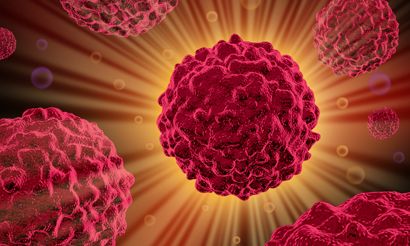Maximizing Immunotherapy Approaches in Hard-to-Treat Cancers
Cancer proliferates when a rogue, transformed cell wins a sophisticated hide-and-seek game against the immune system. Immunotherapy activates the patient’s immune system to recognize and fight the tumor cells.
Cancer proliferates when a rogue, transformed cell wins a sophisticated hide-and-seek game against the immune system. Immunotherapy activates the patient’s immune system to recognize and fight the tumor cells.

Cancer proliferates when a rogue, transformed cell wins a sophisticated hide-and-seek game against the immune system. Immunotherapy activates the patient’s immune system to recognize and fight the tumor cells. The therapeutic antitumor response can be modulated at multiple points in immune surveillance by using checkpoint inhibitors, oncolytic viruses (OVs), adoptive cell transfer (ACT), and other approaches.
Tetanus Toxoid Priming of Vaccine in Glioblastoma
Although significant clinical benefits have been demonstrated with individual treatments, success has been limited to a subset of patients and a subset of cancers. Consequently, difficult-to-treat cancers may require immunotherapeutic strategies that are specific to individual patients.Tetanus toxoid priming may boost survival benefit of dendritic cell vaccine in hard-to-treat patients with glioblastoma, new research suggests.1Glioblastoma, the most common and the most difficult-to-treat brain tumor, has a poor prognosis, with a median survival of 14 months after diagnosis.
In their pilot clinical trial, Mitchell et al reported significantly improved therapeutic benefit by priming patients with a tetanus booster 1 day before the administration of dendritic cell vaccine pulsed withCytomegalovirusphosphoprotein 65 (pp65) RNA. They observed improved lymph node homing and efficacy of tumor-antigenspecific dendritic cells, after conditioning with tetanus/diphtheria (Td) toxoid.
Virus-Loaded Stem Cells Cross BloodBrain Barrier in Glioblastoma
Measles Virus Efficacy in Myeloma
Twelve patients with glioblastoma, randomized equally into 2 groups, received first-line therapy of dendritic cell vaccine pulsed with Cytomegalovirus pp65. The treatment group (n = 6) additionally received a tetanus injection a day before immunotherapy. While the immunotherapy-only group showed a modest increase in life expectancy (average 18.5 months) a 50% patient survival was observed in the combination group 5 years (60 months) after diagnosis (one patient is alive to date, 9 years after diagnosis).Another approach to treat glioblastomas uses stem cells as pathotropic delivery vehicles, using their inherent tumor tropism. In a preclinical study, Duebgen et al showed improved survival rates for mice with glioblastoma multiforme (GBM) after application of human mesenchymal stem cells (MSC) loaded with oncolytic herpes simplex virus (MSC-oHSV) stem cells.2Real-time tracking of MSC-oHSVs introduced into the tumors showed effective HSV progeny production leading to GBM death. Prolonged median survival in mice (P <.001 with Gehan-Breslow-Wilcoxon test) was observed after therapy. Shah, the lead investigator of the study hopes to translate these benefits into clinical studies where the virus-loaded stem cells could be applied adjacent to the tumor during tumor debulking surgery.Stephen J. Russell, MD, PhD, professor and director, molecular medicine, Mayo Clinic, Rochester, Minnesota has presented clinical data on 2 patients with myeloma who were treated with an oncolytic measles virus expressing sodium iodide symporter.3Both patients responded to the virus treatment, showing reduction of both bone marrow cancer and myeloma protein. One patient, a 49-year-old woman, experienced complete remission of her multiple myeloma and was clear of the cancer for more than 6 months. These patients were not responsive to other therapies and had experienced several recurrences of their disease.
“There are over 3000 viruses known,” Russell communicated to Targeted Oncology. “Each virus attacks and kills its target cells and invades its host species following a unique series of steps. All of them can be adapted for safety, engineered for specificity, and modified to include additional genes not normally present in the original virus genome. I consider all of them to be independent (potential) drugs in an emerging drug class. Certainly, I have my preferences as to which are most likely to show benefit but the advantages and disadvantages of a specific class have to be considered in light of the biology of the virus relative to the biology of the tumor being attacked, and the goals of therapy, that is, direct destruction of the tumor cells/amplification of the anticancer immune response/destruction of the tumor microenvironment, etc.”
Reovirus and Programmed Death-1 (PD-1) Blockade
T-VEC and Checkpoint Inhibitors.
According to Russell, although these findings are exciting, safety is a big factor to consider when using such technologies. “Thankfully, the field is heavily regulated. We cannot ignore the potential of OVs to become harmful to the patients given their [OVs] inherent capacity for evolution,” stressed Russell.Pharmaceutical companies trying to market such therapies have also joined the race to find optimum combination partners to boost therapeutic effect of their OVs. Oncolytics Biotech collaborators recently presented preclinical data at an AACR tumor immunology and immunotherapy conference. EntitledCombination therapy with Reovirus and PD-1 blockade effectively establishes tumor control via innate and adaptive immune responses,4the study reported significantly enhanced survival with the coadministration of systemic anti-PD-1 antibody with reovirus compared with intratumoral reovirus alone (P <.01). In the study, 40% of the mice were cured long-term. The survival benefit was achieved by augmenting tumor-specific natural killer (NK) responses as well as by attenuating tumor-specific immunosuppression.Talimogene laherparepvec (T-VEC) is a modified herpes simplex 1 virus that secretes the cytokine granulocyte-macrophage colony-stimulating factor (GM-CSF) within the tumor, causing cell lysis. Up-regulation of inhibitory checkpoint receptors such as cytotoxic T-lymphocyte-associated antigen-4 (CTLA-4) or programmed death (PD) prevents an antitumor attack targeting lysed cytokines and tumor-derived antigens. Combining OVs such as T-VEC with checkpoint inhibitors can potentially enhance therapeutic activity. Several clinical trials are assessing T-VEC effect in combination with immune checkpoint inhibitors. A phase II, randomized study is evaluating the safety and efficacy of T-VEC in combination with ipilimumab versus ipilimumab alone in advanced melanoma.5Another clinical trial is investigating T-VEC in combination with PD-1 antibodies like pembrolizumab in patients with melanoma to evaluate better therapeutic potential.
TGF-β Blockade in T-Cell-ReceptorEngineered Immunotherapy for Ovarian Cancer
Russell summarized the potential of combination therapy, “It makes sense to combine oncolytics with other therapies. If anticancer immunity is cross-primed when the immune system comes in to destroy the virus-infected cancer cells, then the resulting anticancer T cells are unlikely to kill remaining uninfected tumor cells unless their natural defense system is dismantled. That is precisely what the checkpoint inhibitor antibodies do. This also potentially will address the current limitation of the checkpoint inhibitors, which is that they are unlikely to work unless there is an army of antitumor T cells (such as can result from cross-priming during the OV infection) waiting to attack the tumor”.Richard Koya, MD, PhD, associate professor of oncology and director of the vector development and production facility at Roswell Park Cancer Institute, Buffalo, New York, will lead a clinical trial this summer to test antitumor efficacy of engineered T-cell-receptor (TCR) immunotherapy in patients with ovarian cancer.
The trial is based on a preclinical study showing superior antitumor activity of TCR-engineered immunotherapy against B16 melanoma.6The innovative gene therapy technique, developed in his laboratory, causes transforming growth factor-beta (TGF-β) blockade by TCR-engineered immunotherapy. In preclinical studies, the dominant negative TGF-β RII retrovirus, encoding a truncated receptor lacking the entire kinase domain and most of juxtamembrane region, worked as a decoy receptor that rendered T cells insensitive to TGF-β signaling and prevented resistance to inhibition by T regulatory cells.
A New Era in Immunotherapy
“Immunotherapy based on this kind of cellular therapy is a very attractive, novel approach because it can potentially lead to long-term improvement, if not a real cure for cancer in some patients,” said Koya. “Very impressive results have been seen in melanoma and certain leukemias. We are positive that this same approach can be extended to many other cancers.” Koya said.Personalized immunotherapeutic approaches are vast and various and many are still in the early stages of study. “Many experts in the field are really excited about the possibility of enhancing the function and activity of T cells in attacking and destroying the tumor. Genetic engineering, combination with different drugs, modulation of the immunosuppressive tumor microenvironment, and oncolytics are also being tested for combination therapy to enhance T-cell-based immunotherapy,” Koya said. Overall, the era for combination immunotherapy to treat cancers seems to have arrived.
References
- Mitchell DA, Batich KA, Gunn MD, et al. Tetanus toxoid and CCL3 improve dendritic cell vaccines in mice and glioblastoma patients [published online ahead of print March 11, 2015].Nature. doi:10.1038/nature14320.
- Duebgen M, Martinez-Quintanilla J, Tamura K, et al. Stem cells loaded with multimechanistic oncolytic herpes simplex virus variants for brain tumor therapy.J Natl Cancer Inst. 2014;106(6).
- Mayo Clinic. Study shows virotherapy promising against multiple myeloma. Forefront. 2014; http://www.mayo.edu/research/forefront/study-shows-virotherapy-promising-against-multiple-myeloma. Accessed March 23, 2015.
- Oncolytics Biotech. http://www.oncolyticsbiotech.com/news/press-release-details/2014/Oncolytics-Biotech-Inc-Collaborators-Present-REOLYSIN-and-Checkpoint-Inhibitor-Combination-Preclinical-Data-at-AACR-Tumor-Immunology-and-Immunotherapy-Conference/default.aspx. Accessed March 12, 2015.
- Amgen. Ipilimumab With or Without Talimogene Laherparepvec in Unresected Melanoma. http://clinicaltrials.gov/show/NCT01740297. NLM identifier: NCT01740297. Accessed March 17, 2015.
- Quatromoni JG, Wang Y, Vo DD, et al. T cell receptor (TCR)-transgenic CD8 lymphocytes rendered insensitive to transforming growth factor beta (TGFβ) signaling mediate superior tumor regression in an animal model of adoptive cell therapy.J Transl Med. 2012;10:127.
<<<

Survivorship Care Promotes Evidence-Based Approaches for Quality of Life and Beyond
March 21st 2025Frank J. Penedo, PhD, explains the challenges of survivorship care for patients with cancer and how he implements programs to support patients’ emotional, physical, and practical needs.
Read More